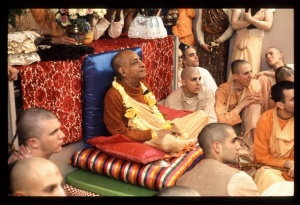CC Madhya 14.191: Difference between revisions
m (1 revision(s)) |
No edit summary |
||
| Line 1: | Line 1: | ||
{{ | [[Category:Sri Caitanya-caritamrta - Madhya-lila Chapter 14|C191]] | ||
<div style="float:left">'''[[Sri Caitanya-caritamrta|Śrī Caitanya-caritāmṛta]] - [[CC Madhya|Madhya-līlā]] - [[CC Madhya 14|Chapter 14: Performance of the Vṛndāvana Pastimes]]'''</div> | |||
<div style="float:right">[[File:Go-previous.png|link=CC Madhya 14.190|Madhya-līlā 14.190]] '''[[CC Madhya 14.190|Madhya-līlā 14.190]] - [[CC Madhya 14.192|Madhya-līlā 14.192]]''' [[File:Go-next.png|link=CC Madhya 14.192|Madhya-līlā 14.192]]</div> | |||
{{CompareVersions|CC|Madhya 14.191|CC 1975|CC 1996}} | |||
{{RandomImage}} | |||
==== TEXT 191 ==== | ==== TEXT 191 ==== | ||
<div | <div class="verse"> | ||
mukhe-netre haya nānā-bhāvera udgāra | :mukhe-netre haya nānā-bhāvera udgāra | ||
ei kāntā-bhāvera nāma ‘lalita’-alaṅkāra | :ei kāntā-bhāvera nāma ‘lalita’-alaṅkāra | ||
</div> | </div> | ||
| Line 12: | Line 16: | ||
==== SYNONYMS ==== | ==== SYNONYMS ==== | ||
<div | <div class="synonyms"> | ||
''mukhe''—on the mouth; ''netre''—on the eyes; ''haya—''there are; ''nānā-bhāvera''—of various ecstasies; ''udgāra''—the awakening; ''ei''—this; ''kāntā-bhāvera''—of the condition of the female; ''nāma''—the name; ''lalita''—of lalita; ''alaṅkāra''—the ornament. | |||
</div> | </div> | ||
| Line 19: | Line 23: | ||
==== TRANSLATION ==== | ==== TRANSLATION ==== | ||
<div | <div class="translation"> | ||
“When there is an awakening of the various ecstatic features on Śrīmatī Rādhārāṇī’s face and in Her eyes that are appropriate to a charming feminine attitude, the lalita ornament is manifest. | “When there is an awakening of the various ecstatic features on Śrīmatī Rādhārāṇī’s face and in Her eyes that are appropriate to a charming feminine attitude, the lalita ornament is manifest. | ||
</div> | </div> | ||
__NOTOC__ | |||
<div style="float:right; clear:both;">[[File:Go-previous.png|link=CC Madhya 14.190|Madhya-līlā 14.190]] '''[[CC Madhya 14.190|Madhya-līlā 14.190]] - [[CC Madhya 14.192|Madhya-līlā 14.192]]''' [[File:Go-next.png|link=CC Madhya 14.192|Madhya-līlā 14.192]]</div> | |||
__NOTOC__ | |||
__NOEDITSECTION__ | |||
Revision as of 15:21, 1 September 2021

His Divine Grace
A.C. Bhaktivedanta Swami Prabhupada
A.C. Bhaktivedanta Swami Prabhupada
TEXT 191
- mukhe-netre haya nānā-bhāvera udgāra
- ei kāntā-bhāvera nāma ‘lalita’-alaṅkāra
SYNONYMS
mukhe—on the mouth; netre—on the eyes; haya—there are; nānā-bhāvera—of various ecstasies; udgāra—the awakening; ei—this; kāntā-bhāvera—of the condition of the female; nāma—the name; lalita—of lalita; alaṅkāra—the ornament.
TRANSLATION
“When there is an awakening of the various ecstatic features on Śrīmatī Rādhārāṇī’s face and in Her eyes that are appropriate to a charming feminine attitude, the lalita ornament is manifest.